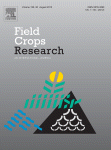Ver ítem
- xmlui.general.dspace_homeCentros Regionales y EEAsCentro Regional Santa FeEEA OliverosArtículos científicosxmlui.ArtifactBrowser.ItemViewer.trail
- Inicio
- Centros Regionales y EEAs
- Centro Regional Santa Fe
- EEA Oliveros
- Artículos científicos
- Ver ítem
N:P:S stoichiometry in grains and physiological attributes associated with grain yield in maize as affected by phosphorus and sulfur nutrition
Resumen
Balanced nutrition is necessary to reduce yield gaps in maize. Simultaneous phosphorus (P) and sulfur (S) deficiencies may be present in soils, so a P × S interaction is expected. In maize, yield is closely related to grain number (GN); thus, nutrient deficiencies impacting crop growth during GN formation can consequently impact yields. Grain nutrient concentration may reflect soil supplying capacity, and nutrient stoichiometry in grains can be used as an
[ver mas...]
Balanced nutrition is necessary to reduce yield gaps in maize. Simultaneous phosphorus (P) and sulfur (S) deficiencies may be present in soils, so a P × S interaction is expected. In maize, yield is closely related to grain number (GN); thus, nutrient deficiencies impacting crop growth during GN formation can consequently impact yields. Grain nutrient concentration may reflect soil supplying capacity, and nutrient stoichiometry in grains can be used as an indirect indicator of nutrient deficiency for a retrospective diagnosis of sites responsive to P or S fertilization. The objectives of this study were to: i) determine maize response to increasing S fertilizer rates and to P addition; ii) analyze the effects of P, S, and their interaction on mechanisms involved in yield determination of maize; and iii) evaluate the effects of P and S shortage on stoichiometric relationships among N, P, and S content in maize grains. Two fertilization experiments were conducted on-farming conditions in 19 sites-year (SY) for analyzing grain yield response to increasing S fertilizer rates (E1), and studying the interaction between P and S fertilization on grain yield and physiological attributes associated with grain yield determination (E2), i.e. CGRCP, IPARCP, RUECP and biomass at R6. Also N (%N), S (%S) and P (%P) concentration in grains were determined. Stoichiometric relationships among N, P and S in both P or S fertilized and unfertilized treatments in all SY were analyzed. Average grain yield response due to S and P addition was ca. 13 and 20%, respectively. Grain yield increased up to S fertilizer rates around 10 kg S ha−1. P addition increased CGRCP by 15–60% in 8 SY while S addition 12–16% in 2 SY. Both, RUECP and IPARCP were positively associated with biomass production. P fertilization increased IPARCP by 4%, but no S effect was observed. Before silking, P addition boosted cumulated radiation by 7%, but after silking no P or S effects were observed. A significant P × S interaction was observed for RUECP, since S fertilization increased RUECP by 14% only when P was not added. Independently of P or S shortage, grain N content scaled almost isometrically with grain S content, while N:P and P:S showed allometric relationships. Phosphorus deficiency did not modify N:S, N:P nor P:S stoichiometry. Likewise, S addition did not modify the N:P or N:S stoichiometry. A significant change in the intercept of the P:S relationship was observed in response to fertilization and may be used as a tool for identifying S responsive sites using grain nutrient analysis.
[Cerrar]

Autor
Salvagiotti, Fernando;
Prystupa, Pablo;
Ferraris, Gustavo Nestor;
Couretot, Lucrecia Alejandra;
Magnano, Luciana;
Dignani, Damian;
Gutierrez Boem, Flavio Hernán;
Fuente
Field crops research 203 : 128-138. (March 2017)
Fecha
2017-03
ISSN
0378-4290
Formato
pdf
Tipo de documento
artículo
Palabras Claves
Derechos de acceso
Restringido
 Excepto donde se diga explicitamente, este item se publica bajo la siguiente descripción: Creative Commons Attribution-NonCommercial-ShareAlike 2.5 Unported (CC BY-NC-SA 2.5)
Excepto donde se diga explicitamente, este item se publica bajo la siguiente descripción: Creative Commons Attribution-NonCommercial-ShareAlike 2.5 Unported (CC BY-NC-SA 2.5)

